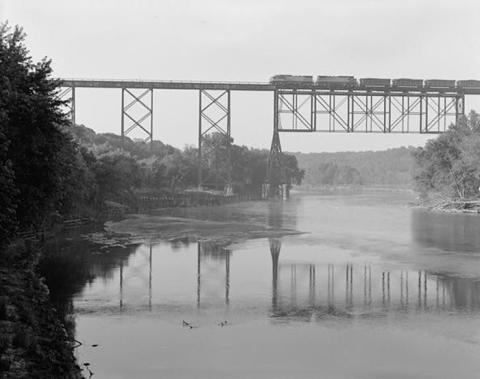
Description
The image shows a view of the Chicago & North Western railroad viaduct (Kate Shelley High Bridge) over the Des Moines River from the north. According to the Historic American Engineering Record, this viaduct is about 3,000 feet long, 185 feet above the Des Moines River, made of 6,196 tons of steel and has a double track. At that time, there were only three other viaducts similar to this one in the world: Pennsylvania, Texas and Bolivia, and all were smaller than this one. The Historic American Engineering Record also said that railroad tracks needed to be very solid because any sagging could cause train derailment, but the river valley was unstable because it was sand, shale, mud and silt. The solution was to dig down eight pneumatic caissons, each 10 feet in diameter, so these additions would be deep enough to reach stable sandstone bedrock, anywhere from 42 to 62 feet below. These caissons supported the piers closest to the river, four on each side. The remaining piers were supported by shallower foundations because they supported less weight.
Source-Dependent Questions
- The middle of the bridge, the part spanning the river, looks different than the two sides that do not span the river. Why would bridge engineer George Morison design the viaduct so that no posts or supports were in the water?
- What is the benefit of having a double track across the viaduct instead of a single track?
Citation Information
"Elevatin of Truss, From North, With Train - Chicago & Northwestern Railroad Viaduct, Spanning Des Moines River at Chicago & Northwestern Railroad tracks, Boone, Boone County, IA," Historic American Engineering Record. Courtesy of Library of Congress